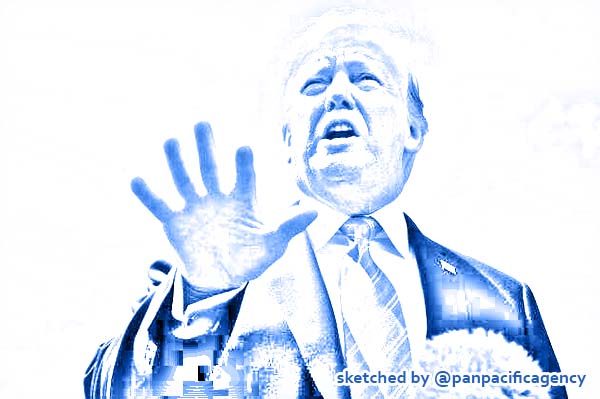Trump declares a national emergency over the coronavirus

President Donald Trump speaks to the media prior to departing on Marine One from the South Lawn of the White House in Washington, DC, May 14, 2019. Saul Loeb | AFP | Getty Images. Sketched by the Pan Pacific Agency.
WASHINGTON D.C., Mar 13, 2020, LAT. President Trump invoked emergency powers Friday, declaring a national emergency over the coronavirus outbreak, which will allow more federal aid to flow to states and municipalities. “To unleash the full power of the federal government, I’m officially declaring a national emergency. Two very big words,” the president said during a news conference in the Rose Garden, Los Angeles Times reported.
Trump, who had been under mounting pressure from Democrats to make such a declaration in order to free up some $40 billion in federal money for states, began by listing the actions he had already taken in response to the epidemic, but then pivoted.
“We’re doing a tremendous job,” he said. “Now we’re in a different phase.”
Trump urged states to immediately set up emergency operations centers and vowed to “vastly increase and accelerate our capacity to test” for the virus, addressing an issue that has become a serious logistical and political liability in recent days. He trotted out a series of business executives who worked with the White House to set up a new testing system that will allow the U.S. to establish “drive-through” testing centers similar to those currently in use in South Korea.
But he reiterated several times that not everyone should take the test and again sought to calm public fears about the pandemic.
“We don’t want everybody taking this test,” Trump said. “It’s totally unnecessary, and this will pass.”
The announcement came an hour after House Speaker Nancy Pelosi (D-San Francisco) partially preempted Trump by making a public statement from the Capitol, outlining legislation she has negotiated largely with Treasury Secretary Steven T. Mnuchin that, she said, would ensure that coronavirus testing is free for all Americans, including the uninsured.
“We can only defeat this outbreak if we have an accurate determination of its scale and scope,” said Pelosi.
Like former Vice President Joe Biden a day earlier, she delivered remarks standing in front of a row of American flags — a symbolic gesture by Democrats suggesting an eagerness to grasp the trappings of the presidency at a moment when Trump’s leadership is under intense scrutiny.
House Democrats vowed to vote Friday on their legislation or an amended version agreed to by the White House, which has balked at some of the elements that go beyond providing temporary relief to those affected by the coronavirus.
If the House pushes ahead without clear support from the administration, any bill coming out of the House would face more serious hurdles in the Republican-controlled Senate, which is expected to take up the legislation next week.
Trump also spoke Friday with French President Emmanuel Macron, who tweeted that the Group of Seveb leaders had agreed to take part in a video conference Monday to better coordinate efforts to slow the global pandemic and mitigate its sweeping economic fallout.
Prices rebounded Friday ahead of Trump’s speech, with the Dow gaining 3.5% in afternoon trading.
Other major stock indexes also dived Thursday despite efforts by the Trump administration and the Federal Reserve to calm skittish investors, sending the market into so-called bear territory, or 20% or more below the record highs the markets set only last month.
That ended the 11-year bull market in stocks, the longest ever, that began during the financial crisis in 2009.
Despite Friday’s upswing, the Dow was on track to post a loss of nearly 15% for the week, during which the sell-off became so intense that trading had to be halted for 15 minutes on two separate days under regulatory “circuit breakers” aimed at preventing an overwhelming cascade of sell orders.
In the Oval Office on Thursday, Trump declared himself an expert on the Stafford Act.
“We have very strong emergency powers under the Stafford Act,” Trump told reporters. “I have it memorized, practically, as to the powers in that act. And if I need to do something, I’ll do it. I have the right to do a lot of things that people don’t even know about.”
Trump’s overall nonchalance about the coronavirus pandemic so far has stood in increasingly stark contrast to state and municipal leaders, as well as private sector executives who have in recent days taken action on their own to shut down school districts, close offices, museums and other businesses and cancel major events, including the NCAA March Madness tournament.
Democrats have been urging the president this week to make an emergency declaration, which would allow states to request a 75% federal cost-share for expenses related to virus response and mitigation efforts — things including emergency workers, medical tests, medical supplies and vaccinations.
The president, however, has been reluctant to make such a move, largely out of concern that it would contradict his numerous public statements over the last month that attempted to downplay concerns over the coronavirus in hopes of lessening its impact on financial markets.